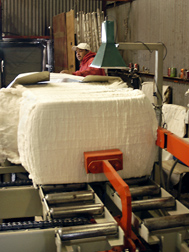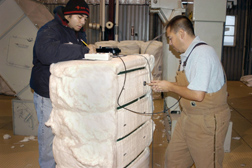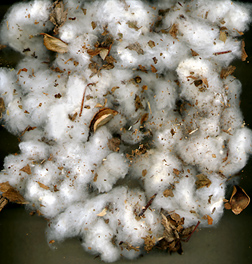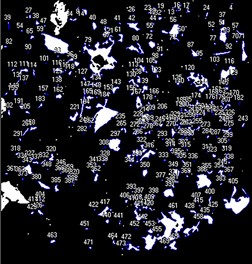Automated Monitoring of Cotton Bale Moisture
|
|
In recent years, there have been more incidents in which large numbers of cotton bales—up to an entire season’s worth from all the farmers who used a particular cotton gin—were ruined due to excessive use of moisture-restoration systems. Intensive analysis of several of these bales revealed moisture levels that ranged from below 7 percent to well above 13 percent within a single bale.
ARS engineer Mathew Pelletier says that while the loss of some 50,000 bales in one year is a very small number compared to a crop of 18 to 20 million bales, the loss to that one gin community was devastating.
“As cotton gins began adding new water-spraying equipment to improve bale press operation and reduce bale tie pressure, the number of very wet bales increased, as did the need for an improved cotton-moisture sensor,” Pelletier says.
This situation caused Pelletier and Edward Barnes, director of the agricultural research division of Cotton Incorporated, of Cary, North Carolina, to develop the necessary three-dimensional (3-D) imaging technology to augment the modern microwave moisture-sensing systems previously invented by Pelletier.
Cotton Incorporated, funded by U.S. growers of upland cotton and importers of cotton and cotton textile products, is the research-and-marketing company representing upland cotton. The Cotton Incorporated research program is designed and operated to improve the demand for and profitability of cotton.
Pelletier’s previous microwave sensors used a wide microwave beam to scan bales and provide an average moisture reading. The systems worked well with uniformly moist bales. The need now, however, is to detect the highest moisture point in a bale that could have moisture variability. In earlier studies with ginning systems that used spray moisture restoration, Pelletier and agricultural engineers Rick Byler and Stanley Anthony at the ARS Cotton Ginning Laboratory in Stoneville, Mississippi, found that the wetter a bale is, the more variable the distribution of water within the bale. Anthony has since retired. [See also “New Technologies for Cotton Gins Combine for Big Savings,” Agricultural Research, May 2006, pp. 18-19.]
Pelletier’s new prototype system sends multiple pencil-thin microwave beams through each bale to sensors on opposite sides, creating a 3-D image of the water distribution throughout the entire bale. Preliminary testing on a commercial cotton bale shows that the system can detect high moisture layers and determine average bale moisture. Pelletier also inserted water into the center of a commercially ginned bale of cotton to see whether the system could spot the wet layer. It did.
|
|
The 7.5-Percent Solution
A 7.5-percent moisture level is the maximum safe storage level for cotton bales. Above that, the fiber begins to degrade and the color changes, as shown in research by Anthony, along with Kevin Baker and Ed Hughs, agricultural engineers in the ARS Cotton Ginning Research Unit at Mesilla Park, New Mexico. Anthony’s research found color deterioration for virtually all cotton with moisture levels above 8 percent. And it doesn’t take moisture levels much above 7.5 percent to quickly bring on fiber damage and mold.
In 2006, the USDA Farm Service Agency ruled that cotton bales placed in storage in warehouses as collateral in their Commodity Credit Corporation loan program must not have more than 7.5 percent moisture anywhere in a bale. “Now there is a contractual obligation to accurately identify bale moisture levels,” Pelletier say. The major losses occur when cotton bales are stored for several months, allowing time for mold to form in internal wet spots and eventually rot entire bales.
CAT Scan Can Spot Trouble
The agricultural engineers apply the same tomographic imaging techniques used for CAT scans of the human body. Both take measurements at key points and then use computers and mathematics to extrapolate from those points to reconstruct the whole.
|
|
Pelletier’s system is designed to take measurements at 120 points throughout the bale, with 10 antennae shooting beams into different sides of each bale, at different angles, as the bale passes by on a conveyor belt.
The 3-D imaging system would allow cotton gins to monitor for internal wet spots as well as allow warehouses to screen for high-moisture bales before storage. It could also be used by manufacturers to fine-tune the design of their moisture-restoration equipment.
Pelletier has several patents on sensors to spot debris and moisture and has had cooperative research and development agreements with two cotton gin equipment manufacturers to automatically monitor cotton trash and moisture.
For example, Pelletier has developed a patented machine-vision system that uses cameras to examine—in real time—the trash content (leaves, stems, and other extraneous matter) of the moving bat of lint just before the cotton is loaded into a bale.
“With the globalization of the world cotton market, foreign competition is driving the need to lower production costs. Automated sensing is the future of cotton ginning, just as it is for other industries that process agricultural products,” Pelletier says. “The recent dramatic losses of so many bales in storage called attention to the need for automated monitoring of internal cotton bale moisture variability.”—By Don Comis, Agricultural Research Service Information Staff.

This research is part of Quality and Utilization of Agricultural Products, an ARS national program (#306) described on the World Wide Web at www.nps.ars.usda.gov.
Mathew G. Pelletier is in the USDA-ARS Cotton Production and Processing Unit, 1604 E. FM 1294, Lubbock, TX 79403; phone (806) 746-5353, fax (806) 746-5028.
"Automated Monitoring of Cotton Bale Moisture" was published in the November/December 2008 issue of Agricultural Research magazine.










